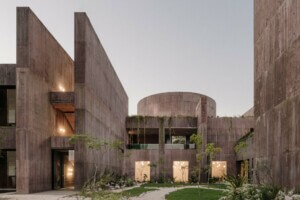Bendable concrete is one step closer to hitting the market. Bendable concrete or Engineered Cementitious Composites (ECC) were originally developed in the 1990s by Victor C. Li at the University of Michigan, whose research was in part inspired by how animals like abalone produce the inner nacre of their shells. However, cost, supply chain concerns, and technical factors have prevented its widespread adaptation in the construction industry and its use has been limited to just parts of a handful of projects in Japan and the United States. However, a new development by Gabriel Arce, a construction management research associate at Louisiana State University is hoping to change that.
Arce led a multi-year project titled “Evaluation of the Performance and Cost-Effectiveness of Engineered Cementitious Composites Produced from Region 6 Local Materials,” which experimented with an array of locally sourceable materials to develop a more cost-effective, scalable bendable concrete. The material, which comprises a PVA fiber, fine grain sand from the Mississippi river, and locally-gathered fly ash, costs more than conventional concrete but much less than existing ECC. “The cost of our material is approximately 2.5 times that of regular concrete; typical ECC cost can be more than four times that of regular concrete,” said Arce in a university publication. Considering the fact that structures using ECC can be built with less material and require less upkeep and repair, the gap in cost may actually be negligible.
Bendable concrete is filled with small fibers, generally polymer-derived, organized into a microstructure that helps give the material increased ductility in comparison to traditional concrete, which is prone to cracking and failure under strain and long-term use. Where standard cement only has a strain capacity of around .01 percent, bendable concrete’s can be as much as 7 percent, meaning it is hundreds of times more flexible. Its fibrous structure also means it breaks in a safer, slower way—generating many “microcracks” instead of the large cracks seen in traditional concrete. This means wear leads to smaller deformations, rather than full-on shattering or structural failure. This is critical as most failures in concrete structures, are due not to a lack of compressive strength, but tensile strength, as Li explained in an article he published this past year in The Conversation. Traditional concrete simply can’t bend or give without breaking. Besides making infrastructure and buildings unsafe, these cracks, which can occur after a few years of use, require substantial amounts of time, material, and carbon output to repair. Over time this adds substantially to the financial and environmental cost of the building.
Arce, whose project was funded by the Transportation Consortium of South-Central States (Tran-SET), an association of several universities across the southern half of the U.S., hopes to see bendable concrete used to help alleviate problems with this country’s decaying, and often poorly maintained, infrastructure. This past October he put the new ECC to the test, using the material to repair a section of Baton Rouge sidewalk—it’s not building a bridge, dam, or tower, but it was hopefully a step towards building a safer, more durable, and more sustainable world.











